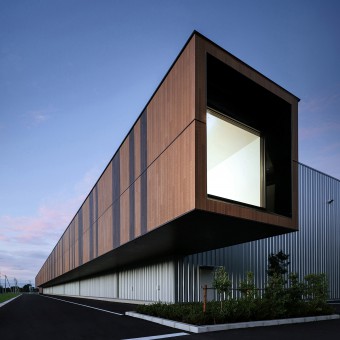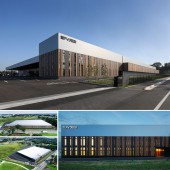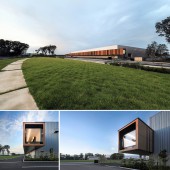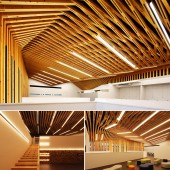
| THE AWARD |
| CATEGORIES |
| REGISTRATION |
| SUBMIT YOUR WORK |
| ENTRY INSTRUCTIONS |
| TERMS & CONDITIONS |
| PUBLICATIONS |
| DATES & FEES |
| METHODOLOGY |
| CONTACT |
| WINNERS |
| PRESS ROOM |
| GET INVOLVED |
| DESIGN PRIZE |
| DESIGN STORE |
| THE AWARD | JURY | CATEGORIES | REGISTRATION | PRESS | WINNERS | PUBLICATIONS | ENTRY INSTRUCTIONS |
Aida Sekkei Precut Factory by Nobuaki Miyashita |
Home > Winners > Design #160159 >Interview |
 |
|
FS: What is the main principle, idea and inspiration behind your design?
NM: The primary principle behind my design for the AIDA Precut Division was to architecturalize the timber processing itself. The inspiration came from the desire to visualize the simple yet precise process of cutting high-quality laminated wood collected from around the world, embodying the quality of housing through the design of the factory.
FS: What has been your main focus in designing this work? Especially what did you want to achieve?
NM: My main focus while designing this work was to ensure that the precision of the precut technology translated into the overall aesthetic and functionality of the space. I aimed to create a design that not only facilitates efficient production but also symbolizes the quality of AIDA Design’s housing.
FS: What are your future plans for this award winning design?
NM: For this award-winning design, my future plans include continuing to refine and adapt the functional aspects of the facility to accommodate advancements in precut technology and sustainable building practices.
FS: How long did it take you to design this particular concept?
NM: The design process for this particular concept took approximately eight months, from initial concept to final plans.
FS: Why did you design this particular concept? Was this design commissioned or did you decide to pursuit an inspiration?
NM: This design was commissioned by AIDA Design as they sought a new factory that would be at the core of their housing quality. I decided to pursue a concept that would reflect the integral nature of their work in timber precutting.
FS: Is your design being produced or used by another company, or do you plan to sell or lease the production rights or do you intent to produce your work yourself?
NM: The design is currently being realized by AIDA Design itself. There are no plans to sell or lease the production rights as it is bespoke to their specific operational needs.
FS: What made you design this particular type of work?
NM: I designed this particular type of work to embody the integration of industrial functionality with architectural aesthetics, aiming to create a space that reflects the precision and quality of AIDA Design’s work.
FS: Where there any other designs and/or designers that helped the influence the design of your work?
NM: While the concept was primarily my own innovation, I did draw general inspiration from traditional Japanese timber architecture to inform some of the structural decisions.
FS: Who is the target customer for his design?
NM: The target customer for this design is not a consumer in the traditional sense but serves the operational needs of AIDA Design’s precut division and indirectly serves their housing customers by ensuring high-quality building components.
FS: What sets this design apart from other similar or resembling concepts?
NM: What sets this design apart is its integration of the operational pathways and structural elements into a coherent architectural statement that not only serves practical purposes but also communicates the identity and future vision of AIDA Design.
FS: How did you come up with the name for this design? What does it mean?
NM: The name for this design, "AIDA Precut Division," is straightforward—it directly describes its function within the company but also underscores its foundational role in the quality of the housing produced.
FS: Which design tools did you use when you were working on this project?
NM: I used a variety of design tools, including CAD software for precise architectural planning and 3D modeling tools to visualize and refine the spatial arrangements and structural elements.
FS: What is the most unique aspect of your design?
NM: The most unique aspect of my design is the method of extracting necessary functional volumes from a massive block, which symbolizes the precision and minimal waste in AIDA Design’s production process.
FS: Who did you collaborate with for this design? Did you work with people with technical / specialized skills?
NM: I collaborated with engineers specializing in wood construction and precut technology to ensure that every aspect of the design was both feasible and functional.
FS: What is the role of technology in this particular design?
NM: Technology played a critical role in this design, particularly through the use of advanced CAD and simulation tools to optimize the layout and structural integrity of the factory.
FS: Is your design influenced by data or analytical research in any way? What kind of research did you conduct for making this design?
NM: Yes, my design was influenced by analytical research, particularly in optimizing the flow of materials and ensuring minimal waste. This involved studying various production processes and layouts that maximize efficiency.
FS: What are some of the challenges you faced during the design/realization of your concept?
NM: One of the main challenges was integrating the functional requirements of a precut factory with a high aesthetic value that reflects the company’s identity, requiring a balance between form and function.
FS: How did you decide to submit your design to an international design competition?
NM: I decided to submit this design to an international competition to showcase how industrial facilities can be designed with high architectural standards and to bring recognition to the innovations AIDA Design is implementing in the housing industry.
FS: What did you learn or how did you improve yourself during the designing of this work?
NM: During the design process, I learned to better integrate aesthetic considerations with industrial functionality, which improved my ability to create designs that are both practical and visually compelling.
FS: Any other things you would like to cover that have not been covered in these questions?
NM: I believe this interview covers the essential aspects of the design, but I would add that this project represents a significant step in how architectural practices can directly enhance industrial efficiency and environmental sustainability.
FS: Thank you for providing us with this opportunity to interview you.
A' Design Award and Competitions grants rights to press members and bloggers to use parts of this interview. This interview is provided as it is; DesignPRWire and A' Design Award and Competitions cannot be held responsible for the answers given by participating designers.
| SOCIAL |
| + Add to Likes / Favorites | Send to My Email | Comment | View Press-Release |




